Claude III Martinot
Further images
-
(View a larger image of thumbnail 1
)
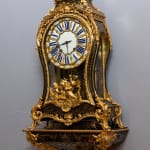
-
(View a larger image of thumbnail 2
)
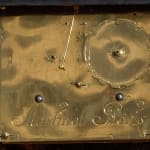
-
(View a larger image of thumbnail 3
)
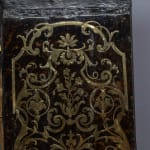
-
(View a larger image of thumbnail 4
)
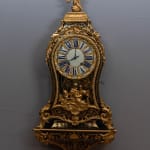
-
(View a larger image of thumbnail 5
)
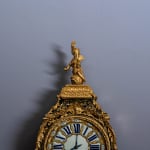
-
(View a larger image of thumbnail 6
)
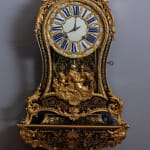
-
(View a larger image of thumbnail 7
)
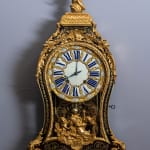
-
(View a larger image of thumbnail 8
)
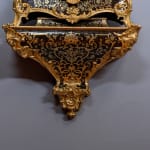
A rare and very beautiful Louis XV gilt bronze mounted mantel clock with bracket by Claude III Martinot of fourteen days duration, veneered in première partie Boulle marquetry of engraved brass and tortoiseshell, signed on the backplate of the movement Martinot à Paris. The finely rocaille chased dial with a central white enamel plate surrounded by blue Roman hour numerals within shaped enamel cartouches and outside black Arabic numerals for the five minute intervals within lozenge-shaped enamel cartouches, with a fine pair of blued steel hands for the hours and minutes. The movement with silk thread suspension, striking on a single bell, with outside count wheel. The gilt bronze mounted Boulle marquetry case of waisted outline decorated overall with rocaille floral and foliate garlands and gadrooned borders, surmounted on the flattened hood by the figure of a seated maiden wearing a plumed headdress and tunic, holding a bird in her hand, with further foliate rocaille mounts flanking the upper part of the case and continuing down below the dial, mounted below the dial by two young merchildren, one of which rides a hippocampus and like it rise out of water above a central cockle shell, the clock with glazed sides and decorated within the interior with radiating Boulle inlays on the floor and at the back with floral sprays and scrolling arabesque Boulle inlays, the case supported on scrolled cabriole foliate feet, the splayed bracket again with elaborate foliate rocaille mounts terminated by an architectural and foliate boss
Paris, date circa 1730-40
Overall height 115 cm, width of clock 46 cm, depth 17 cm. Bracket height 30 cm, width 48 cm.
A very similar Louis XV mantel clock with bracket veneered in Boulle marquetry of engraved brass and tortoiseshell is in the British Royal Collection. Surmounting its domed top, it features the same gilt bronze seated maiden but without the accompanying bird; below the dial is a low relief scene of Neptune carrying off Amphitrite in a chariot drawn by four hippocampi as opposed to the single hippocampus and merchildren that we see here. The British Royal Collection clock was purchased by Lord Ravensworth for King George IV. Like many clocks in the king’s collection, in 1838 its movement was replaced by one made by the royal clockmaker Benjamin Lewis Vulliamy, though the original movement is believed to have been made by the Paris clockmaker Jean Caillouet (b. 1733).
Our clock’s movement was made by Claude III Martinot (1691-1744) who belonged to a large and distinguished dynasty of Paris clockmakers. He was the son of Elizabeth née Giradon and Henry Martinot (1646-1725), Valet de Chambre-Horloger Ordinaire du Roi and in turn married Marie-Jeanne-Madeleine Richer, granddaughter of Jean Jans Tapissier Ordinaire du Roi aux Gobelins. Following the death of his father, Claude Martinot lodged in the Galeries du Louvre and for that reason sometimes signed his clocks Martinot au Louvre and Martinot aux Galeries. At various stages and like his father, Claude served as Valet de Chambre-Horloger Ordinaire du Roi and also ran a very active workshop.
One of his most notable clocks, which he invented in 1727, indicated true and median time on four dials and displayed astronomical indications on a fifth dial. At the time of Martinot’s death, that clock was owned by the painter, engraver, art commentator, and playwright Charles Coypel and was subsequently acquired by the clockmaker Julien Le Roy. When writing about the clock, Le Roy noted that Martinot “having prepared a drawing for an equation clock, without faults of those which open at the centre of the dial, thought of using M. Le Bon’s idea of a keyless clock. Martinot made his in such a way that the dial, the plaque, and the minute hand really do all rise and fall by means of the ellipse.” The clock itself was housed in a gilt bronze mounted frame designed by the esteemed artist and goldsmith Juste-Aurèle Meissonnier (1695-1750), who is known for his exuberant Rococo designs. In addition to his own, Martinot also used cases made by the ébénistes Charles Cressent as well as André-Charles Boulle. Examples by the latter include a mantel clock in the Wallace Collection, London which is inscribed on the backplate of the movement C. Martinot Galleries du Louvre. 1726. The Wallace Collection clock is housed in a sumptuous case by André-Charles Boulle and features the figure of Love at its summit and the figure of Father Time below the dial. The present case is certainly of the same quality, style and design to Boulle’s work and may very well be by the master himself.
Cultivated in the arts, Claude Martinot had an extensive library of books, which at his death contained more than seven hundred volumes. He also traded in engravings, using the twelve plates of the Galerie de M. de Giradon and seven of the Cabinet des Antiques de M. Giradon, which he had inherited, and then purchased a quarter share in a company, which financed and sold the engravings the Histoire de Don Quichotte by Charles Coypel, making a profit of 17,502 livres from the takings of 43,350 livres.







